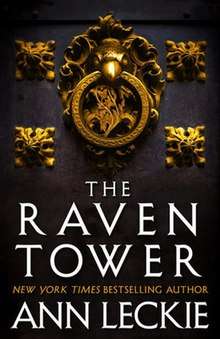The Raven Tower
The Raven Tower is a 2019 fantasy novel by Ann Leckie. It is her first fantasy novel. Based on the story of Hamlet, it recounts the story of Mawat, a prince seeking to overthrow his usurper uncle and regain his rightful place as the servant of a local god. He is accompanied by Eolo, his loyal retainer. Parts of the story are also narrated by a nature deity.
 Cover art for The Raven Tower | |
| Author | Ann Leckie |
|---|---|
| Language | English |
| Genre | Fantasy literature |
| Published | 26 February 2019 |
| Publisher | Orbit Books |
| Media type | Print, ebook |
| Pages | 465 pages |
| ISBN | 978-0316388696 |
| Website | https://annleckie.com/novel/the-raven-tower/ |
Plot
In the Raven Tower universe, many gods of varying levels of power exist. Anything that a god says becomes true; speaking a paradox may injure or kill a god. Gods may take the physical forms of animals or landmarks. The story is narrated by The Strength and Patience of the Hill, a god who inhabited a large boulder and later a millstone. Strength and Patience also discusses its long life, from prehistoric times through the arrival of humans. The country of Iraden is protected by various gods, including the Raven. The port city of Vastai is ruled by the Raven’s Lease, a human who is granted vast power in exchange for a shortened lifespan. When the Raven’s possessed bird dies, the Lease must die as well.
Mawat, son of the Lease and commander of Iraden’s army, receives a message that his father is ill. Mawat is accompanied by his retainer, a transgender man named Eolo. When they arrive in Vastai, Mawat’s father has disappeared and his uncle Hibal is the new Lease. Mawat publicly accuses Hibal of foul play, threatening Vastai’s stability and trade relationships with other territories. In particular, members of the Xulhan Empire and their snake god are seeking a new alliance with Hibal.
Eolo discovers that Mawat’s father is being held prisoner in the dungeons of the Raven Tower. He also discovers that Strength and Patience has been enslaved by the Raven. Strength and Patience has been protecting Vastai while the Raven’s power has secretly been weakening. Mawat, believing he is serving the Raven, inadvertently frees Strength and Patience from the Raven’s control. Mawat is then framed for murdering a high-ranking politician. A flood causes a dysentery outbreak and hostile forces begin invading, revealing that the Raven is no longer able to protect Vastai. Mawat kills Hibal and is then killed by the snake god. Strength and Patience states that he has killed the Raven. He vows to protect Eolo, but decides to leave Vastai to its fate.
Style
Strength and Patience describes its existence through first person narrative. It describes Eolo in the second person. This allows the reader to see the thoughts of Strength and Patience, while Eolo is only described from an external perspective. Thus, though we can see Eolo's actions, the reader is blind to his internal monologue. The contrast between the two styles invites the reader to consider whether Strength and Patience is omitting important details.[1] Many of Strength and Patience's statements are written in the subjunctive mood or are framed as rumors.[2]
Background
The Raven Tower is a loose retelling of Hamlet by William Shakespeare. While Strength and Patience's narration is original, the plot which takes place inside Vastai parallels the plot of the original Shakespearean story. Mawat serves as the analogue for Hamlet, while his loyal retainer Eolo serves as Horatio. Other similarities include the presence of a woman named Tikaz, who embodies some of the characteristics of Ophelia. Despite the similarities to Shakespeare's plot, a reviewer for Tor.com found that the presence of multiple gods in the story "reweaves the fabric of Shakespeare’s play into cloth of a different colour entirely."[1]
Reception
The novel received acclaim from critics. Kirkus Reviews gave a positive review, praising its "philosophical musings about politics, power, and revenge" and applauding its depth despite a relatively short page count for a fantasy novel.[3] A reviewer for The Guardian called it "groundbreaking" and "a gripping tale of intrigue and politics".[4] A reviewer for NPR praised its exploration of the political system of Vastai, as well as the contrast between the narratives of the human characters and the gods.[5] Reviews for Locus magazine praised the story's originality despite its use of familiar building blocks. The review called it "a thoughtful reimagining of a genre, a re-examination featuring... variations, inversions, and overturned expectations."[2] The book was also praised by a reviewer from Spectrum Culture for its inclusion of a well-written transgender lead character in a genre that has not historically been kind to queer characters.[6]
References
- Liz Bourke (26 Feb 2019). "Striking and Ambitious Fantasy: The Raven Tower by Ann Leckie". Tor.com. Retrieved 16 March 2020.
- Adrienne Martini; Russell Letson (20 April 2019). "Adrienne Martini & Russell Letson Review The Raven Tower by Ann Leckie". Locus. Retrieved 18 March 2020.
- "The Raven Tower". Kirkus Reviews. 13 Nov 2018. Retrieved 18 March 2020.
- Eric Brown (15 March 2019). "The best recent science fiction and fantasy - review roundup". The Guardian. Retrieved 18 March 2020.
- Genevieve Valentine (28 Feb 2019). "'The Raven Tower' Rises From Shakespearean Foundations". NPR. Retrieved 18 March 2020.
- 28 July 2019. "The Raven Tower by Ann Leckie". Spectrum Culture. Retrieved 18 March 2020.